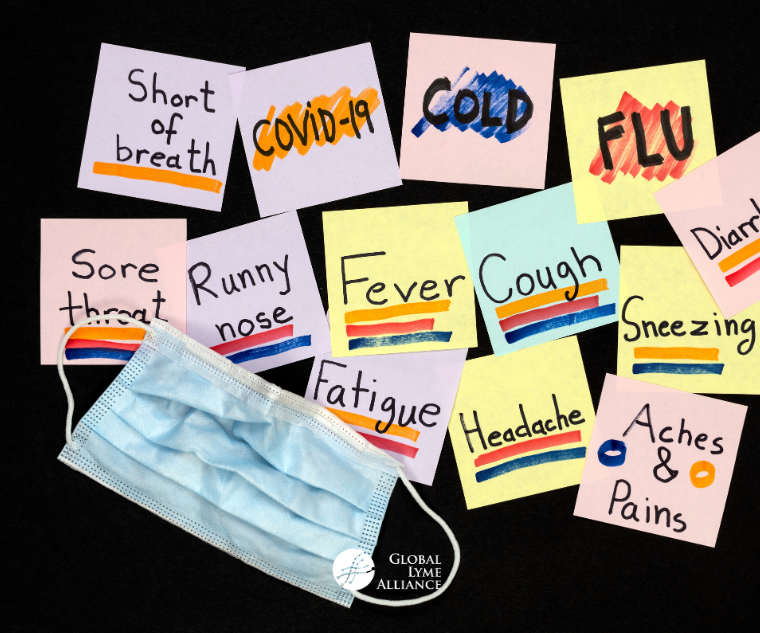
Tens of thousands of people in the U.S. have lingering illness following COVID-19, known as post-Covid “long haulers.” Why do some people recover relatively quickly from Lyme disease and Covid-19, and a significant number do not?
by Mayla Hsu, Ph.D., Director of Research and Science, GLA
What do Covid-19 and Lyme disease have in common? Both are infectious diseases that any of us can catch. Both are diseases that emerged from wildlife. The science underlying both illnesses is still being learned. And it’s increasingly recognized that a subset of Covid-19 patients, like Lyme disease patients, suffers long-term debilitating symptoms that may take months or even longer to lift.
Among the thousands who have seemingly recovered from Covid-19, some continue to suffer. This can occur in both patients who had severe illness months after hospital discharge, as well as those with milder outpatient symptoms. A follow-up study of 143 Italian Covid-19 patients who had been hospitalized, treated, and discharged, showed that 44% had worsened quality of life compared to pre-Covid-19, more than a month after hospital discharge. Among these patients, 53% reported persisting fatigue, 43% had sleep difficulties, and 27% had joint pain. With over 10 million reported Covid-19 cases in the US at the time of this writing, this could translate to many patients with debilitating symptoms, requiring further medical care and support.
Lyme patients who have been diagnosed and treated yet continue to experience symptoms often face disbelief or perplexity from doctors that the continued issues are attributable to their initial infection. Chronic pain, debilitating fatigue, sleep dysfunction and cognitive difficulties are commonly reported. The heterogeneity in symptoms and the subjective nature of some of them have made a single case definition elusive. However, a growing understanding and characterization of post-treatment Lyme disease (PTLD) is emerging. Mathematical modeling by GLA with Allison DeLong of Brown University suggests that up to two million Americans may suffer from PTLD by the end of 2020, making it a significant public health concern.
Some similarities in symptoms in post-Covid-19 and PTLD patients suggest there may be common biology in these individuals. There are hints that Covid-19 patients may have self-directed or autoimmune responses that develop after infection with SARS-CoV-2, the virus that causes the disease. A new paper published on medRxiv (pronounced “Med Archive”) analyzed autoreactive antibodies and inflammatory biomarkers in severely ill Covid-19 patients. Although the findings are preliminary and have not undergone peer review, they still suggest some promising areas of inquiry, and hopefully, the findings will soon be validated.
In 44% of severely ill Covid-19 patients, they found elevated anti-nuclear antibodies, a characteristic of patients with systemic lupus erythematosus, an autoimmune disease. In all hospitalized Covid-19 patients, they found elevated C-reactive protein (CRP), with average levels at 191 mg/L. In healthy people, CRP is normally less than 10 mg/L. In PTLD patients, elevated autoantibodies and C-reactive protein have also been documented.
For both PTLD and Covid-19, carefully studying patients from the beginning of their disease and onwards may help to identify predictive biomarkers that show who is at risk for developing longer-term symptoms. This would help to optimize initial treatment so that prevention is possible. Early studies suggest that this may be within reach.
An important study published by GLA grant recipient Dr. John Aucott of Johns Hopkins University, identified high blood serum levels of CCL19, an inflammatory cytokine, as an important predictor of Lyme patients who were more likely to develop PTLD. Dr. Aucott’s team found that patients with CCL19 levels of >111.67 pg/ml one month after antibiotic treatment had almost 13 times higher risk of developing PTLD at 6 or 12 months later. The authors suggest that elevated CCL19 may be an indicator of ongoing, persistent immune responses. While still in a research stage, this finding shows promise to inform clinicians how to better identify and manage Lyme disease patients destined to have long-standing symptoms.
For Covid-19 patients, such a prognostic biomarker might be found in studying ferritin, the storage molecule for iron. One recent study focused on Covid-19 patients with 60 days or more of persistent lung pathology. Patients with more severe initial Covid-19 disease had highly elevated CRP and ferritin, and these two biomarkers were associated with non-resolving, longer-term lung pathology. The initial viral infection is believed to drive the production of IL-6, an inflammatory cytokine, which in turn elevates ferritin levels. Why levels remain high in some, but not all patients, and the link with continued lung pathology should be studied to determine what mechanism is at work.
It’s clear that more research is needed to understand why some people recover relatively quickly from Lyme disease and Covid-19, and a significant number do not. There are large numbers of individuals who are already suffering from long-term consequences of both infections, and these numbers will only grow. Accurate and thorough testing of patients, together with careful patient histories, is crucial to establishing long-standing disease correlations. Additionally, the role of host and pathogen genetics is critical to determining the variation in human response to these infections.
Additional COVID-19 and Lyme Disease Resources from GLA:
Letter: GLA Chairman on COVID 19: Am I Immune?
GLA POV: Parallel Pandemics: COVID-19 and Lyme Disease
Blog: Q&A on COVID-19 and Lyme Disease with LLMD
Blog: Personal Patient Experience with COVID-19 and Lyme Disease
Letter: GLA Chairman on What We Can Learn from COVID-19 Response
Blog: Why Are Virus Infections Like COVID-19 Resistant to Antibiotics?

Mayla Hsu, Ph.D.
Former Director of Science & Research at Global Lyme Alliance






-2.jpg)